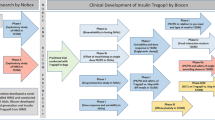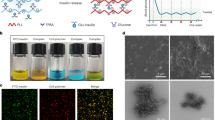Abstract
Purpose
To develop a long-acting formulation of native human insulin with a similar pharmacodynamics (PD) profile as the insulin analogue insulin glargine (Lantus®, Sanofi-Aventis) with the expectation of retaining native human insulin’s superior safety profile as insulin glargine is able to activate the insulin-like growth factor 1 (IGF-1) receptor and is linked to a number of malignancies at a higher rate than regular human insulin.
Methods
Development of protected graft copolymer (PGC) excipients that bind native human insulin non-covalently and testing blood glucose control obtained with these formulations in streptozotocin-induced diabetic Sprague Dawley rats compared to equally dosed insulin glargine.
Results
PGC-formulations of native human insulin are able to control blood glucose to the same extent and for the same amount of time after s.c. injection as the insulin analogue insulin glargine. No biochemical changes were made to the insulin that would change receptor binding and activation with their possible negative effects on the safety of the insulin.
Conclusion
Formulation with the PGC excipient offers a viable alternative to biochemically changing insulin or other receptor binding peptides to improve PD properties.

Blood glucose development in STZ-diabetic Sprague Dawley rats after s.c. injection of 1 mg/kg regular human insulin formulated with formulations 605c, 421a, and 421b, or an equivalent dose of insulin glargine.



Similar content being viewed by others
Abbreviations
- BG:
-
blood glucose
- NPH:
-
Neutral Protamine Hagedorn insulin
- PGC:
-
Protected graft copolymer
- STZ:
-
streptozotocin
References
Bolli GB, et al. Insulin analogues and their potential in the management of diabetes mellitus. Diabetologia. 1999;42(10):1151–67.
Campbell RK, et al. Insulin glargine. Clin Ther. 2001;23(12):1938–57. discussion 1923.
Heise T, Heinemann L. Rapid and long-acting analogues as an approach to improve insulin therapy: an evidence-based medicine assessment. Curr Pharm Des. 2001;7(14):1303–25.
Hirsch IB. Insulin analogues. N Engl J Med. 2005;352(2):174–83.
McKeage K, Goa KL. Insulin glargine: a review of its therapeutic use as a long-acting agent for the management of type 1 and 2 diabetes mellitus. Drugs. 2001;61(11):1599–624.
Porcellati F, et al. Comparison of pharmacokinetics and dynamics of the long-acting insulin analogs glargine and detemir at steady state in type 1 diabetes: a double-blind, randomized, crossover study. Diabetes Care. 2007;30(10):2447–52.
Kurtzhals P, et al. Correlations of receptor binding and metabolic and mitogenic potencies of insulin analogs designed for clinical use. Diabetes. 2000;49(6):999–1005.
Le Roith D. Insulin glargine and receptor-mediated signalling: clinical implications in treating type 2 diabetes. Diabetes Metab Res Rev. 2007;23(8):593–9.
Staiger K, et al. Comparison of the mitogenic potency of regular human insulin and its analogue glargine in normal and transformed human breast epithelial cells. Horm Metab Res. 2007;39(1):65–7.
Liefvendahl E, Arnqvist HJ. Mitogenic effect of the insulin analogue glargine in malignant cells in comparison with insulin and IGF-I. Horm Metab Res. 2008;40(6):369–74.
Mayer D, Shukla A, Enzmann H. Proliferative effects of insulin analogues on mammary epithelial cells. Arch Physiol Biochem. 2008;114(1):38–44.
Weinstein D, et al. Insulin analogues display IGF-I-like mitogenic and anti-apoptotic activities in cultured cancer cells. Diabetes Metab Res Rev. 2009;25(1):41–9.
Bloomgarden Z, Handelsman Y. Cancer mortality and insulin glargine. J Diabetes. 2009;1(3):131–3.
Colhoun HM. Use of insulin glargine and cancer incidence in Scotland: a study from the Scottish Diabetes Research Network Epidemiology Group. Diabetologia. 2009;52(9):1755–65.
Currie CJ, Poole CD, Gale EA. The influence of glucose-lowering therapies on cancer risk in type 2 diabetes. Diabetologia. 2009;52(9):1766–77.
Dejgaard A, et al. No evidence of increased risk of malignancies in patients with diabetes treated with insulin detemir: a meta-analysis. Diabetologia. 2009;52(12):2507–12.
Gale EA. Insulin glargine and cancer: another side to the story? Lancet. 2009;374(9689):521.
Garg SK, Hirsch IB, Skyler JS. Insulin glargine and cancer–an unsubstantiated allegation. Diabetes Technol Ther. 2009;11(8):473–6.
Hemkens LG, et al. Insulin glargine and cancer. Lancet. 2009;374(9703):1743–4. author reply 1744.
Hemkens LG, et al. Risk of malignancies in patients with diabetes treated with human insulin or insulin analogues: a cohort study. Diabetologia. 2009;52(9):1732–44.
Home PD, Lagarenne P. Combined randomised controlled trial experience of malignancies in studies using insulin glargine. Diabetologia. 2009;52(12):2499–506.
Idris I. Observational registry database studies link insulin glargine with cancer risk. Diabetes Obes Metab. 2009;11(9):910–2.
Jonasson JM, et al. Insulin glargine use and short-term incidence of malignancies-a population-based follow-up study in Sweden. Diabetologia. 2009;52(9):1745–54.
Pocock SJ, Smeeth L. Insulin glargine and malignancy: an unwarranted alarm. Lancet. 2009;374(9689):511–3.
Rosenstock J, et al. Similar risk of malignancy with insulin glargine and neutral protamine Hagedorn (NPH) insulin in patients with type 2 diabetes: findings from a 5 year randomised, open-label study. Diabetologia. 2009;52(9):1971–3.
Dawson LK, Hamilton LA. Risk of cancer in patients receiving insulin glargine. Am J Health Syst Pharm. 2010;67(23):2025–31.
Hernandez-Diaz S, Adami HO. Diabetes therapy and cancer risk: causal effects and other plausible explanations. Diabetologia. 2010;53(5):802–8.
Nagel JM, et al. Insulin resistance and increased risk for malignant neoplasms: confounding of the data on insulin glargine. Diabetologia. 2010;53(1):206–8.
Bogdanov Jr AA, et al. A new macromolecule as a contrast agent for MR angiography: preparation, properties, and animal studies. Radiology. 1993;187(3):701–6.
Habeeb AFSA. Determination of free amino groups in proteins by trinitrobenzenesulfonic acid. Anal Biochem. 1966;14(3):328–36.
Caliceti P, Veronese FM. Pharmacokinetic and biodistribution properties of poly(ethylene glycol)-protein conjugates. Adv Drug Deliv Rev. 2003;55(10):1261–77.
Fishburn CS. The pharmacology of PEGylation: balancing PD with PK to generate novel therapeutics. J Pharm Sci. 2008;97(10):4167–83.
Bolli GB, Owens DR. Insulin glargine. Lancet. 2000;356(9228):443–5.
Gillies PS, Figgitt DP, Lamb HM. Insulin glargine. Drugs. 2000;59(2):253–60. discussion 261-2.
Levien TL, et al. Insulin glargine: a new basal insulin. Ann Pharmacother. 2002;36(6):1019–27.
Reinhart L, Panning CA. Insulin glargine: a new long-acting insulin product. Am J Health Syst Pharm. 2002;59(7):643–9.
Acknowledgements & Disclosures
The work described in this publication has been supported by the NIH/NIDDK SBIR grant 5R44 DK069727-04 and 3R44DK069727-04S1. We also thank Ms. Cynthia C. Jones for expert help in editing and proof reading the manuscript.
Sandra Reichstetter, Man Shun Lai, Akiko Nishimoto-Ashfield, Gerardo Castillo, and Elijah Bolotin are paid employees and stock option holders of PharmaIN Corporation. Alexei Bogdanov is a shareholder of PharmaIN Corporation.
Author information
Authors and Affiliations
Corresponding authors
Rights and permissions
About this article
Cite this article
Reichstetter, S., Castillo, G.M., Lai, M. et al. Protected Graft Copolymer (PGC) Basal Formulation of Insulin as Potentially Safer Alternative to Lantus® (Insulin-Glargine): A Streptozotocin-Induced, Diabetic Sprague Dawley Rats Study. Pharm Res 29, 1033–1039 (2012). https://doi.org/10.1007/s11095-011-0646-8
Received:
Accepted:
Published:
Issue Date:
DOI: https://doi.org/10.1007/s11095-011-0646-8




